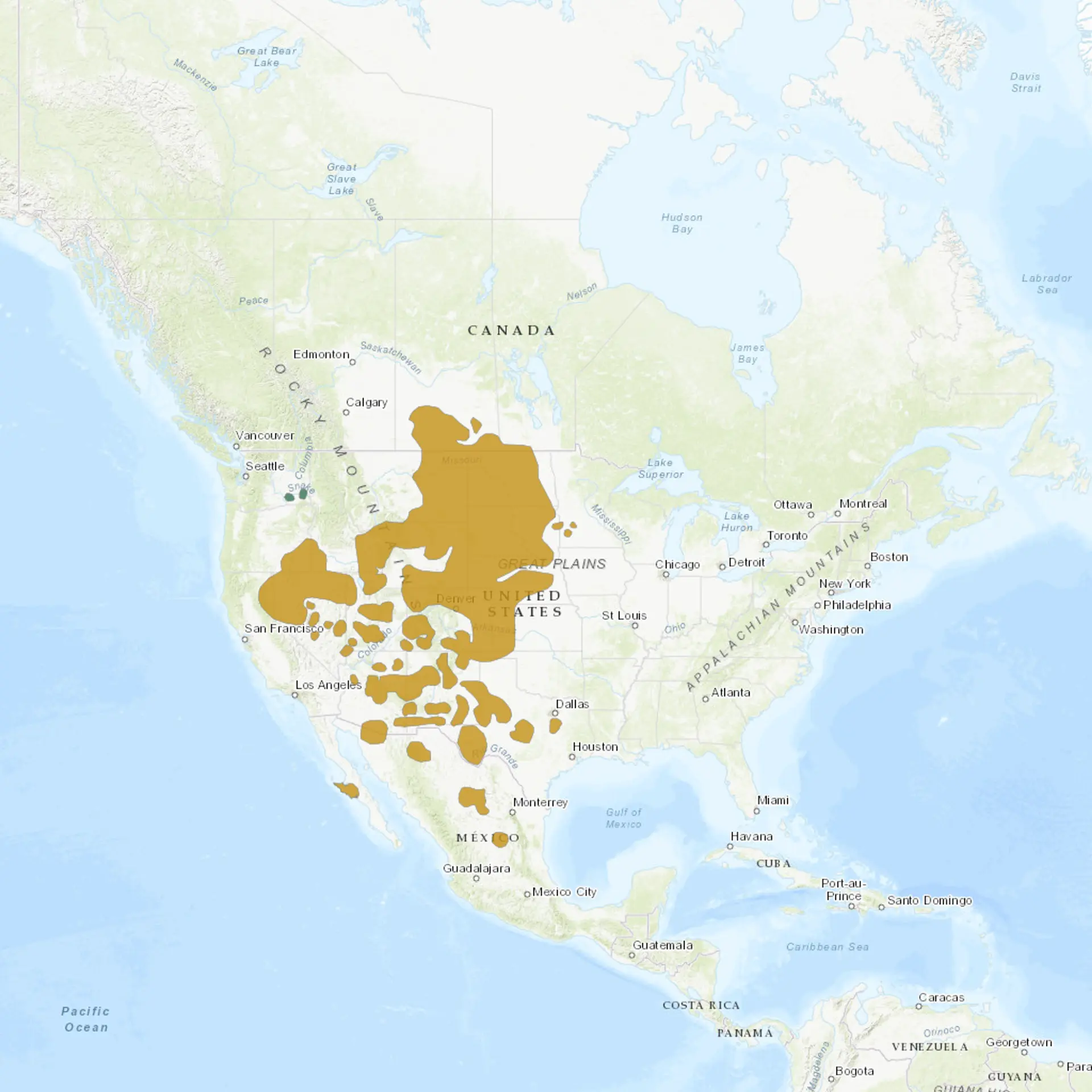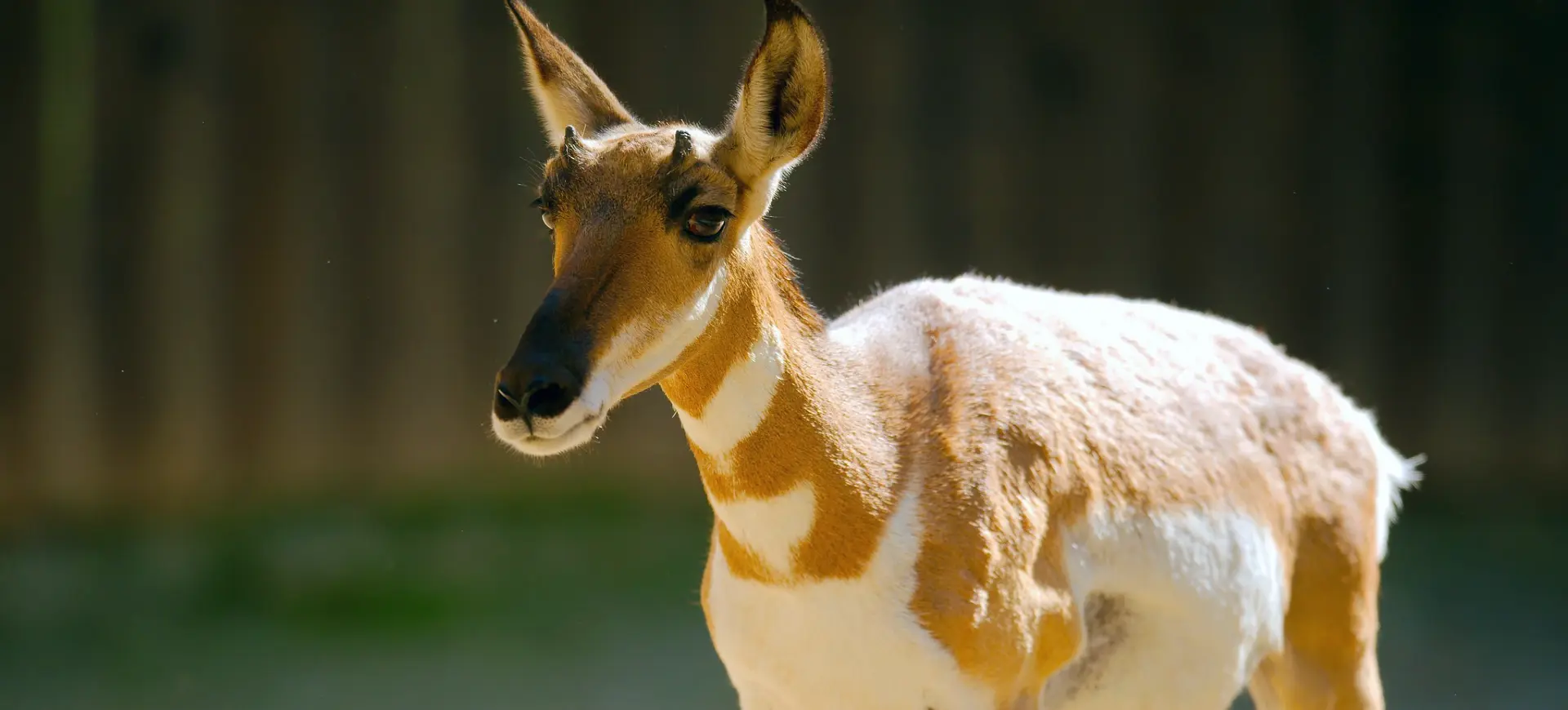Overview
The pronghorn (Antilocapra americana) is a unique North American mammal embodying the American West’s spirit. Known for its remarkable speed, the pronghorn can run faster than any other land mammal in the Western Hemisphere, making it an exceptional species in mobility and endurance. Its distinct appearance, characterized by its tan to reddish-brown coat, white underbelly, and pronounced white stripes on the neck, sets it apart from other North American wildlife. The pronghorn is also notable for its namesake horns, which are unlike any other animal: both males and females have horns, but those of the male are longer and can grow up to 20 inches with a prong, giving the species its name.
Pronghorns are highly adaptable, thriving in various environments, from grasslands and deserts to high plains and basins. Their complex social structure changes with the seasons, forming mixed-sex herds in the winter and separating into male-dominated bachelor groups and female-offspring groups in the breeding season. The pronghorn’s diet primarily consists of grasses, forbs, and shrubs, reflecting its adaptation to its arid and semi-arid habitats. Conservation efforts have successfully reversed the decline of pronghorn populations, showcasing the resilience of this species and the effectiveness of wildlife management strategies.
The pronghorn’s migration patterns are among the longest of any terrestrial mammal in North America, demonstrating their critical ecological role in maintaining the health and connectivity of various ecosystems. These migrations are essential for accessing seasonal food sources and avoiding harsh weather, showcasing the pronghorn’s remarkable ability to navigate vast landscapes.
Taxonomy
Kingdom
Phylum
Class
Order
Family
Genus
Species
Sub Species
Type
Current distribution:
Pronghorns are widely distributed across the western United States, southern Canada, and northern Mexico, extending from Saskatchewan and Alberta in Canada, through the Great Plains and deserts of the United States, to Baja California and the northern states of Mexico. This extensive range reflects their adaptability to various environmental conditions, from grasslands and sagebrush steppes to desert areas.
Conservation programs and habitat restoration efforts have contributed to the stability and growth of pronghorn populations in many areas. However, habitat fragmentation and migration barriers, such as fences and roads, affect their distribution, significantly challenging their movement and access to seasonal habitats. Efforts to maintain and enhance pronghorn corridors are crucial for ensuring their habitats' connectivity and populations' long-term viability. Preserving these areas is key to supporting pronghorns' ecological role and migrations, vital for their survival and reproduction.
Physical Description:
Pronghorns possess a unique and distinguishable physical appearance, characterized by their sleek body, long legs, and short tails, contributing to their incredible speed and agility. Males are easily distinguishable by their prominent, forked horns that shed annually, while females have shorter, straighter horns that are not shed. The coat of the pronghorn changes seasonally, offering camouflage against predators and harsh weather conditions. Their large eyes are positioned on the sides of their head, providing a wide field of vision crucial for detecting predators.
The physical attributes of pronghorns are highly adapted to their lifestyle as fast runners, with cushioned hooves that absorb shock and a large windpipe, heart, and lungs that support their high-speed endurance. Male pronghorns are generally larger than females, with both sexes displaying significant sexual dimorphism in size and horn structure. This species’ coloration and markings serve as effective camouflage and social signals among individuals. The pronghorn’s ability to maintain high speeds over long distances is unmatched in the animal kingdom, showcasing their evolutionary adaptations to evade predators.

Lifespan: Wild: ~14 Years || Captivity: ~7 Years

Weight: Male: 90-150 lbs (41-68 kg) || Female: 75-105 lbs (34-48 kg)

Length: Male: 47-59 inches (119-150 cm) || Female: 45-53 inches (114-135 cm)

Height: Male: 35-40 inches (89-102 cm) || Female: 32-36 inches (81-91 cm)

Top Speed: 60 mph (97 km/h)
Characteristic:
Native Habitat:
Pronghorns are native to North America’s grasslands, deserts, and shrublands, ranging from southern Canada through the United States to northern Mexico. They prefer open terrains with high visibility, and predators can be easily spotted. Their habitats are characterized by wide, open spaces that allow for their high-speed pursuits, whether for escaping predators or during seasonal migrations. Pronghorns have adapted to various climatic conditions, from the cold winters of Canada to the hot deserts of Mexico.
The adaptability of pronghorns to different habitats is reflected in their ability to find food and water sources across these varied landscapes. They are often found where agricultural lands intersect with their natural habitats, demonstrating their ability to coexist with human-altered environments. Conservation efforts focus on preserving these habitats and maintaining migration corridors that are critical for the survival of pronghorn populations. The preservation of pronghorn habitat is essential for maintaining the ecological diversity and health of North American grasslands and deserts.
Climate Zones:
Biomes:
WWF Biomes:
Biogeographical Realms:
Continents:
Countries:
Diet:
Diet & Feeding Habits:
Pronghorns are herbivores, feeding on a wide variety of vegetation, including grasses, forbs, and shrubs, which they select based on seasonal availability and nutritional content. Their diet adapts to the changing seasons, with a preference for forbs in the spring and summer and grasses and shrubs in the fall and winter. Pronghorns have a unique digestive system that allows them to process the cellulose in plants efficiently, providing them with the necessary energy for their active lifestyle.
The feeding behavior of pronghorns involves grazing and browsing, with movements across their habitat influenced by the availability of food sources. They require access to water sources, although they can derive moisture from the plants they consume. Pronghorns play a significant role in their ecosystems by controlling vegetation growth and serving as prey for predators, contributing to the ecological balance. Their ability to cover large areas for food exemplifies their adaptability to diverse environmental conditions.
Mating Behavior:
Mating Description:
Pronghorns exhibit a polygynous mating system, where dominant males establish territories and mate with multiple females. During the mating season, males defend their territories aggressively against rivals, using their horns in combat to compete for access to females. Females, in turn, choose mates based on the males’ ability to defend territories and provide access to resources. This mating strategy ensures genetic diversity and the health of the pronghorn population.
The breeding season, or rut, occurs in the late summer to early fall. During this time, males display a variety of behaviors to attract females, including scent marking, vocalizations, and visual displays. Gestation lasts approximately 7.5 months, resulting in the birth of one or two fawns in the spring. Pronghorns have one of the highest fetal growth rates among North American ungulates, critical for offspring survival in their open habitats. The young are born well-developed, able to walk shortly after birth, and are hidden by their mothers in vegetation to protect them from predators.
Reproduction Season:
Birth Type:
Pregnancy Duration:
Female Name:
Male Name:
Baby Name:
Social Structure Description:
Pronghorns exhibit a flexible social structure that varies seasonally, with mixed-sex herds forming in the winter and segregating into sex-specific groups during the breeding season. Outside the breeding season, males may form bachelor groups, while females and their offspring group. This social organization allows pronghorns to effectively utilize their habitat, find mates, and protect themselves from predators.
The dominance hierarchy among males plays a significant role in their social structure, influencing access to mates and territories. Female pronghorns also establish social hierarchies, affecting their reproductive success and access to resources. The social bonds within these groups are important for offspring survival, with females often cooperating to detect and deter predators. The social dynamics of pronghorn herds are complex and play a crucial role in their behavior, reproduction, and survival.
Groups:
Conservation Status:
Population Trend:
Pronghorn populations have experienced fluctuations over the past centuries, primarily due to overhunting, habitat loss, and barriers to migration. Conservation efforts have been successful in many areas, leading to the recovery and stabilization of pronghorn numbers. These efforts include habitat restoration, the removal of barriers to migration, and sustainable management practices that ensure the long-term viability of pronghorn populations.
The pronghorn is an indicator species for the health of the grassland and desert ecosystems they inhabit. Monitoring pronghorn populations helps conservationists assess the overall health of these ecosystems and the effectiveness of conservation strategies. The social structure of pronghorns, consisting of seasonal herds and territorial males, plays a crucial role in their survival and reproduction, influencing their population dynamics and distribution across their range.
Population Threats:
The primary threats to pronghorn populations include habitat loss and fragmentation, exacerbated by agricultural expansion, urban development, and construction of roads and fences that obstruct traditional migration routes. Predation by coyotes and bobcats also impacts juvenile survival rates, although adult pronghorns have few natural predators due to their speed.
Climate change poses an emerging threat, altering the ecosystems pronghorns depend on for food and water sources and potentially disrupting their migration patterns. Efforts to mitigate these threats are essential for the conservation of pronghorn populations, involving habitat preservation, the maintenance of migration corridors, and the implementation of wildlife-friendly agricultural and development practices. The pronghorns’ resilience and the success of the conservation measures give hope for their future, but ongoing efforts are necessary to ensure their continued survival.
Conservation Efforts:
Conservation efforts for pronghorns focus on habitat preservation, restoring migration corridors, and reducing barriers to their movement. Collaborative projects between wildlife organizations, government agencies, and landowners aim to enhance the connectivity of pronghorn habitats and ensure their access to essential resources.
Education and outreach programs raise awareness of the pronghorn’s ecological importance and challenges, fostering public support for conservation initiatives. Research and monitoring are integral to these efforts, providing data on pronghorn populations, health, and habitat use that inform management strategies. The success of these conservation efforts is evident in the stabilization and growth of pronghorn populations in many areas, highlighting the effectiveness of targeted conservation strategies in preserving this iconic species.
Additional Resources:
Fun Facts
- Although commonly called “antelope,” Pronghorns are not real Antelopes; their closest living relative is the Giraffe.
- Pronghorns can run at speeds up to 61 mph, making them the second-fastest land animal in the world.
- Their unique digestive system allows them to digest various plants, including some that are toxic to other animals.
- Pronghorn horns are made of keratin and are the only ones shed and regrown annually.
- They have excellent vision, with eyes as large as an elephant’s relative to their body size, providing a 320-degree field of view.
- The pronghorn’s scientific name, Antilocapra americana, means “American antelope-goat,” reflecting its unique characteristics that resemble both antelopes and goats.
- Pronghorns can maintain high speeds for miles, unlike cheetahs, which can only sprint short distances.
- The historical range of pronghorns once included parts of the eastern United States but are now primarily found in the continent’s western half.
- Pronghorn migrations can cover over 300 miles round-trip and are among North America’s longest land mammals.
- Fawns are born with a full fur coat and can walk within just a few days of birth.










